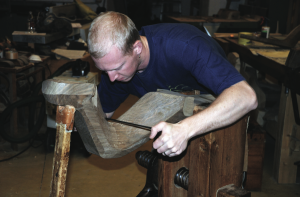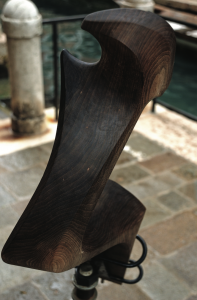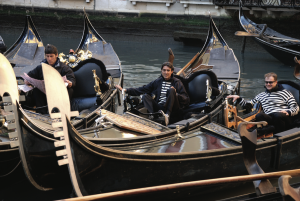Mario Matassa reveals the inside story on the iconic Venetian gondola as he visits the workshops and discovers a tale of tradition, craftsmanship and politics

Changing tides
What a life it must be, meandering day after day through the waterways of the world’s most beautiful city, one man, his boat and not a care in the world. Or so you would think. For the gondolier, and the gondola, the tide is changing. It seems that the boat, boat maker and steersman are under attack from both the port and starboard these days, in a story of tradition, sex and taxes – a very Italian story.
It began when a naval shipyard in Brindisi in the south of Italy offered to make gondolas out of plastic (fibreglass). The new, state-of-the-art, wipe-clean, plastic gondolas come equipped with ‘aircraft technology’ and all at a price that’s right – or rather, less than €25,000 (the cost of the traditional wooden craft).

Traditions are anchored in time and place. The boat builders in Brindisi miss a salient geographical point. It’s like saying they are going to make Capodimonte ceramics in Milan, or Murano glass in Palermo. Every component of the spectacle that is the gondola, down to the hand-crafted shoes the gondolier wears, are made in and around Venice. Many of these artisans are descendants of artisans who have been producing the craft for centuries – it is a tradition that is handed down from one generation to the next. It’s why it belongs in Venice.
And as far as ‘plastic’ is concerned, it’s hardly worth mentioning what today’s 400 gondoliers think of the idea. Aldo Reato, head of the Venice Ente Gondola Association, told the Nuova Venezia daily that the idea was “outrageous… unthinkable… impractical… This is not some amusement park, this is Venice!” Bravo, I say. An image comes to mind of the timeless paintings of gondolas on the Grand Canal depicted by Canaletto and Bellini. I doubt the proposed plastic replicas would have inspired the masters to put their brushes to canvas with similar zeal.
Now I know what you are thinking: what’s the sex angle? It’s not exactly what you might think. You see, the 400 or so gondoliers that roam the canals of Venice today belong to a 1,000-year-old guild
that until recently was one of Italy’s few remaining all-male bastions. Note that I said ‘until recently’. That was before 23-year-old mother of two Giorgia Boscolo was awarded one of the much-coveted and limited licences, making her the first female gondolier in the 900 years of gondoliering history. Giorgia enrolled in the 400-hour course along with two other women, both of whom failed to make the grade. One of them has accused the Gondola Association of being sexist. Sexist? In Italy? The idea is as preposterous as plastic boats!
Personally, I’ve never heard a woman sing the words O Sole Mio. Doesn’t the song need a deep baritone resonance? I suppose they get training for that. Anyway, it’s a minor quibble, and not everyone who sits on a gondola wants to be serenaded – the singing costs extra! Some people just want to be left alone, which brings me to the third part of this modern-day soap opera.
Often when it rains, it pours, they say. Well, for gondoliers, Venice is practically flooding (again)! If plastic boats and women sailors were not enough, in comes the dreaded tax man. The wife of a gondolier (let’s call him Sergio), in a less than harmonious marital break up, decided to take her case to the authorities. She informed the Guardia di Finanzia that her husband wasn’t exactly being honest about his earnings. Sergio has obviously never heard of the dangers of ‘a woman scorned’. The investigation has spread and now over a dozen of Venice’s 400 gondoliers have the tax man on their stern. I suspect poor Sergio isn’t the most popular gondolier on the water.
A taxi ride
Back in the vicinity of Piazza San Marco, I’m tempted to take a ride on a gondola, if only to escape the human traffic for a few minutes. But, like a true Italian, I think better of it. The €100 could be better spent elsewhere – like, for example, on a much anticipated seafood dinner later that evening.
Instead, I find a quiet corner and do a little gondola spotting. Two elderly Americans are sitting in the first boat – the I Love Vegas cap and leather cowboy boots are a dead giveaway. A group of Chinese people follow, talking excitedly and threatening to capsize the boat under the combined weight of all their cameras. Finally a family; at a guess, judging by the fair hair, I would say they were either Dutch or German. As far as I could tell there were no Italians on the gondolas and certainly no Venetians.

It’s not that Venetians do not make use of the gondola. They do. I imagine that in many respects the gondola is to the locals what the red double-decker bus is to Londoners – a convenient way of getting around. But it’s not the highly lacquered or gold decorated version the Venetians take to. I make my way to the Santa Sofia traghetto next to the fish market. There is just enough time before dinner to try one of Venice’s more unusual traditions. The traghetto is the gondola ferry that provides locals with an essential and convenient means of crossing the Grand Canal between the bridges.
These boats differ in three important respects from their touristy counterparts: they are manned by two men as opposed to one; they are the cheapest form of entertainment in Venice (although the locals do not consider them a form of entertainment); and the general protocol is to stand for the duration of the ride.
It’s all about balance. Standing on a boat mid-water, with nothing to hold onto, isn’t easy. It feels unnatural. The other passengers look less phased by the experience. There’s a woman with a pram, two children with school bags, myself and an elderly lady with bags laden with fruit. She must have been to the market. There are no tourists. The ride only takes a few minutes but I know that one wrong move from either of the navigators and I will be treated to an unscheduled dip in the Grand Canal. The locals seem more relaxed. I guess for them it is as natural as taking a bus. I enjoy the ride so much that I take the same boat back.
One thought does occur to me: the gondola is not a toy. As much as the world’s spectators have hijacked the gondola, it’s not a fairground ride, photo op, or object of idle curiosity. It never was intended as such. It’s a memory, a tradition, a necessity, a luxury for tired feet, an indispensable element of the Venetian way of living. Venice wouldn’t be the same if the tradition was lost.
Back on terra firma I can’t shake the lingering image of plastic boats from my mind. I need a distraction. I pass outside the window of a small souvenir shop. I enter, thinking ‘keyrings’ for my two sons. On the shelves, an ominous portent of a possible future: small plastic gondolas on chains are displayed in neat linear formation. The irony doesn’t go unnoticed, but I pick up two anyway, thinking there’s an exception to every rule.
